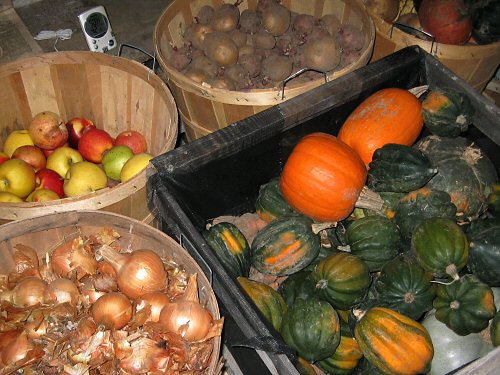
Back in the days of homesteading there were several ways to store food so that is would last you all winter. Canning was an option but most homesteaders didn't have the money or the ability to bring breakable glass jars with them out to the west. Pickling was good but it effected the flavor of food. Salting and drying were also important but the change in flavor was also pronounced and the procedures were time consuming for a people already working dawn till late in the evening just to survive.
So many people used the root cellar or cold room to store produce from the garden and orchard and smoked meats. This form of preservation extended the viability of fresh fruits and veggies with minimal effort. Canning is great, but it takes lots of time, energy (fuel), and expensive equipment.
When we first looked at the house one of the things I loved about it was the huge basement. It already had shelves for canned goods and room for much more. But the problem with the basement is that it is very dry and warm, even in the dead of winter with the furnace off (we use our wood stove to heat the house).
Things like fresh apples and carrots need almost freezing temperatures with good humidity to keep in long storage. So instead of using our basement I decided to try our enclosed back porch. At one time it was just a back porch, but during some point the owners enclosed it. I painted it the colors you see and intended to use it as a sewing room. It stays very very cold in winter and is slightly humid. We call it the dog room because that's where the dog has his food and water dish. Really it is a multipurpose mud/coat room, dog room, cold storage room, and a place I keep all my baking supplies in winter.
I keep all my big baking items like flour, beans, fats, and sugars out here in the winter because my kitchen is so small and lacking in space. In the summer this doesn't work because it heats the food up too much so these items either go back in the kitchen or down to the basement to stay cool. Then into the space they exited I put items I use more often in summer like my canning supplies and pots. The coffee containers hold dried apples, raisins, and other snacks.
This fall I bought close to 100 lbs of apples from a local farmer at 10 cents a pound for our winter use. Much of them went to applesauce but I kept 3 boxes for fresh eating. I bought Gala's for winter storage because they have a very good long storage life. Some apples are just for immediate use, so if you buy them in bulk for winter use make sure they are renowned for good storage. We go through 2 to 4 apples per day so buying them in bulk from the farmer is wise and saves a ton of money.
The experiment was simple. I put the apples in cardboard boxes (they must have some ventilation to allow the natural gasses they produce to escape) closed the lids slightly and then put them under the white table. they have done amazing and now we are at the end of January with one box left. During an unseasonal freeze where temps went below zero I only lost a few to freezing in a box that was almost empty and the lid left open. All the rest are in good condition and still are firm and crunchy.
The Wood Cook Stove you see is a Lang Junior and about 100 years old in perfect condition. This spring we are going to hook it up in the living room. I got it for a steal at a yard sale for $150.00!
As a note you cannot store apples and potatoes together even thought they have very similar storage needs. This is because apples let off a gas that causes the potatoes to sprout.

Great post! I have been wondering where I was going to have my cold room. Still not sure. lol. You did steal that stove. Hey, if you find another one for that price......hint,hint. hehehehe
ReplyDelete